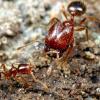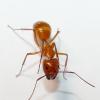- Formiculture.com
- Forums
- Gallery
- Members
- Member Map
- Chat

Interspecies Brood/Callow Acceptance Among genus Camponotus
Started By
LPN1982
, Aug 15 2020 2:27 AM
9 replies to this topic
#1
 Offline
-
Posted August 15 2020 - 2:27 AM
Offline
-
Posted August 15 2020 - 2:27 AM
I would like to get a few opinions and answers with any fellow Camponotus keepers regarding conspecific and heterospecific brood acceptance among the genus Camponotus. I cannot seem to find an answer when searching the internet. I wish to try out a small experiment with my current Camponotus species I have. If anyone has done this before with their Camponotus, I would love to hear about it. The only thing I am afraid of is my founding queen becoming mauled by the callow worker. Here are some questions I am curious about.
1. If I were to place a second or third instar larvae or a pupae from my Camponotus floridanus colony and give it to my founding Camponotus castaneus queen, will she adopt or kill the larvae or perhaps kill the newly eclosed floridanus worker?
2. Will my founding Camponotus castaneus queen be at risk for attack by the newly eclosed floridanus worker?
3. Have certain species of genus Camponotus been more successful than others with actually accepting another Camponotus species within the colony?
1. If I were to place a second or third instar larvae or a pupae from my Camponotus floridanus colony and give it to my founding Camponotus castaneus queen, will she adopt or kill the larvae or perhaps kill the newly eclosed floridanus worker?
2. Will my founding Camponotus castaneus queen be at risk for attack by the newly eclosed floridanus worker?
3. Have certain species of genus Camponotus been more successful than others with actually accepting another Camponotus species within the colony?
- TechAnt likes this
Michael J Borden LPN
Current Keeper Of:
Camponotus floridanus
Camponotus castaneus
Crematogaster ashmeadi
Dorymyrmex bureni
Solenopsis geminata
Current Keeper Of:
Camponotus floridanus
Camponotus castaneus
Crematogaster ashmeadi
Dorymyrmex bureni
Solenopsis geminata
#2
 Offline
-
Posted August 15 2020 - 6:28 AM
Offline
-
Posted August 15 2020 - 6:28 AM
1. Possibly is my best answer, brood and callows being given to young queens has been done with Camponotus spp. and many other genus of ants on the forum. Though Camponotus spp. can sometimes be a little dumb compared to other ants. Though it’s better to do this for parasitic ants or ants of the same species, but even different species have been given to young queens. The only example I recall right now is dspdrew giving brood of his dead Myrmercoystus queens to other founding Myrmercoystus colonies / queens.
2. Probably not, especially not if you refrigerate them for a minute or two. But don’t take my word for it as I’m not an expert. But even if the callow tried to attack, the queen could defend herself / try and get the worker to accept her. Again, don’t take my word for it.
3. I believe some other species of Camponotus have been successful then others, again, again, don’t take my word for it.
This was all my two cents on the topic, but I’m sure more people here know better.
2. Probably not, especially not if you refrigerate them for a minute or two. But don’t take my word for it as I’m not an expert. But even if the callow tried to attack, the queen could defend herself / try and get the worker to accept her. Again, don’t take my word for it.
3. I believe some other species of Camponotus have been successful then others, again, again, don’t take my word for it.
This was all my two cents on the topic, but I’m sure more people here know better.
- LPN1982 likes this
My Ants:
(x1) Campontous semitstaceus ~20 workers, 1 Queen
(x1) Camponotus vicinus ~10 workers, 1 Queen (all black variety)
(x1) Tetramorium immigrans ~100 workers, 1 Queen
(x1) Myrmercocystus mexicanus -1 Queen
(x2) Mymercocystus mimcus -1 Queen
(x1) Mymercocystus testaceus ~45 workers, 1 Queen
(x1) Campontous semitstaceus ~20 workers, 1 Queen
(x1) Camponotus vicinus ~10 workers, 1 Queen (all black variety)
(x1) Tetramorium immigrans ~100 workers, 1 Queen
(x1) Myrmercocystus mexicanus -1 Queen
(x2) Mymercocystus mimcus -1 Queen
(x1) Mymercocystus testaceus ~45 workers, 1 Queen
#3
 Offline
-
Posted August 15 2020 - 6:55 AM
Offline
-
Posted August 15 2020 - 6:55 AM
C. castaneus and C. floridanus are in different subgenera, with castaneus being in the Tanaemyrmex subgenus and floridanus being in the Camponotus subgenus. If you wanted to try this, you probably should get two species within the same subgenus.
- LPN1982, TechAnt and TestSubjectOne like this
"God made..... all the creatures that move along the ground according to their kinds (including ants). And God saw that it was good. Genesis 1:25 NIV version
Keeping:
Tetramorium immigrans Camponotus vicinus, modoc, novaeboracensis, herculeanus
Formica pallidefulva, argentea Solenopsis molesta
Formica cf. aserva Lasius brevicornis, neoniger
#4
 Offline
-
Posted August 17 2020 - 2:38 PM
Offline
-
Posted August 17 2020 - 2:38 PM
Thank you both for your responses and insight with my questions. I will definitely look into it further.
Edited by LPN1982, August 17 2020 - 2:41 PM.
Michael J Borden LPN
Current Keeper Of:
Camponotus floridanus
Camponotus castaneus
Crematogaster ashmeadi
Dorymyrmex bureni
Solenopsis geminata
Current Keeper Of:
Camponotus floridanus
Camponotus castaneus
Crematogaster ashmeadi
Dorymyrmex bureni
Solenopsis geminata
#5
 Offline
-
Posted August 17 2020 - 2:43 PM
Offline
-
Posted August 17 2020 - 2:43 PM
I want to thank you for your opinion and response to my questions. I will definitely look into it further. I will have to familiarize myself more with the subgenus's/taxons.1. Possibly is my best answer, brood and callows being given to young queens has been done with Camponotus spp. and many other genus of ants on the forum. Though Camponotus spp. can sometimes be a little dumb compared to other ants. Though it’s better to do this for parasitic ants or ants of the same species, but even different species have been given to young queens. The only example I recall right now is dspdrew giving brood of his dead Myrmercoystus queens to other founding Myrmercoystus colonies / queens.
2. Probably not, especially not if you refrigerate them for a minute or two. But don’t take my word for it as I’m not an expert. But even if the callow tried to attack, the queen could defend herself / try and get the worker to accept her. Again, don’t take my word for it.
3. I believe some other species of Camponotus have been successful then others, again, again, don’t take my word for it.
This was all my two cents on the topic, but I’m sure more people here know better.
Edited by LPN1982, August 17 2020 - 2:45 PM.
Michael J Borden LPN
Current Keeper Of:
Camponotus floridanus
Camponotus castaneus
Crematogaster ashmeadi
Dorymyrmex bureni
Solenopsis geminata
Current Keeper Of:
Camponotus floridanus
Camponotus castaneus
Crematogaster ashmeadi
Dorymyrmex bureni
Solenopsis geminata
#6
 Offline
-
Posted August 17 2020 - 2:47 PM
Offline
-
Posted August 17 2020 - 2:47 PM
Thank you as well for your opinion and response to my posts questions. I will get myself more familiarized with the subgenus/taxons. Again thank you very much.C. castaneus and C. floridanus are in different subgenera, with castaneus being in the Tanaemyrmex subgenus and floridanus being in the Camponotus subgenus. If you wanted to try this, you probably should get two species within the same subgenus.
Michael J Borden LPN
Current Keeper Of:
Camponotus floridanus
Camponotus castaneus
Crematogaster ashmeadi
Dorymyrmex bureni
Solenopsis geminata
Current Keeper Of:
Camponotus floridanus
Camponotus castaneus
Crematogaster ashmeadi
Dorymyrmex bureni
Solenopsis geminata
#7
 Offline
-
Posted August 17 2020 - 3:36 PM
Offline
-
Posted August 17 2020 - 3:36 PM
I've had success with giving a C castaneus 5 worker colony some C americanus pupae. I tried this again with 5 more pupae the next year and it still worked. It probably works both ways because of the similarity of both species. This is the only other instance of boosting know I of
If you boost her newly eclosed workers she may out right kill them with little chance of injury to her. The instance I worry the most is that the accepted workers will kill the brood.
Edited by akaant, August 17 2020 - 3:53 PM.
- LPN1982 likes this
http://www.formicult...achusetts-only/
Youtube. https://www.youtube....Hbsk2xiarcfGTmw
Keeper of...
Aphaenogaster sp
Camponotus americanus, castaneus, chromaiodes, novaeboracensis, pennsylvanicus.
Crematogaster sp
tetramorium immigrans
Formica sp
#8
 Offline
-
Posted August 17 2020 - 3:51 PM
Offline
-
Posted August 17 2020 - 3:51 PM
Correction, Camponotus floridanus is in the subgenus Myrmothrix, not Camponotus. Surprisingly I have never really experimented with this, but I say go for it IF you have a good supply of floridanus pupae. Though the two species are in different subgenera, it has a chance of working. There was one time that I gave a castaneus queen a tortuganus (=inaequalis) pupa and the queen immediately ate it even though the species are in the same subgenus. I never tried it again and it may have been an isolated incident, though.
- LPN1982 likes this
#9
 Offline
-
Posted August 17 2020 - 7:48 PM
Offline
-
Posted August 17 2020 - 7:48 PM
This is quite fascinating actually. 5 workers from a completely different Camponotus species accepted by the Camponotus castaneus queen. It appears in the video that the foreign workers quickly protected and moved their "alien" castaneus sister brood out of harm's way. So your castaneus queen accepted the Camponotus americanus without issues? Did your 5 americanus workers kill any of the eclosing castaneus callows?I've had success with giving a C castaneus 5 worker colony some C americanus pupae. I tried this again with 5 more pupae the next year and it still worked. It probably works both ways because of the similarity of both species. This is the only other instance of boosting know I of
If you boost her newly eclosed workers she may out right kill them with little chance of injury to her. The instance I worry the most is that the accepted workers will kill the brood.
Michael J Borden LPN
Current Keeper Of:
Camponotus floridanus
Camponotus castaneus
Crematogaster ashmeadi
Dorymyrmex bureni
Solenopsis geminata
Current Keeper Of:
Camponotus floridanus
Camponotus castaneus
Crematogaster ashmeadi
Dorymyrmex bureni
Solenopsis geminata
#10
 Offline
-
Posted August 17 2020 - 7:55 PM
Offline
-
Posted August 17 2020 - 7:55 PM
That is also interesting to hear about. I guess it's a hit or miss mainly huh?Correction, Camponotus floridanus is in the subgenus Myrmothrix, not Camponotus. Surprisingly I have never really experimented with this, but I say go for it IF you have a good supply of floridanus pupae. Though the two species are in different subgenera, it has a chance of working. There was one time that I gave a castaneus queen a tortuganus (=inaequalis) pupa and the queen immediately ate it even though the species are in the same subgenus. I never tried it again and it may have been an isolated incident, though.
I just found an educational list of the genus Camponotus, along with each of their subgenera. I'll see if I can post the link here.
https://www.antwiki....ies_by_Subgenus
Michael J Borden LPN
Current Keeper Of:
Camponotus floridanus
Camponotus castaneus
Crematogaster ashmeadi
Dorymyrmex bureni
Solenopsis geminata
Current Keeper Of:
Camponotus floridanus
Camponotus castaneus
Crematogaster ashmeadi
Dorymyrmex bureni
Solenopsis geminata
0 user(s) are reading this topic
0 members, 0 guests, 0 anonymous users
















